Comprehensive Report on Patient Safety and Human Factors in Hospitals
VerifiedAdded on 2023/01/13
|24
|8721
|45
Report
AI Summary
This report delves into the critical aspects of patient safety and human factors within healthcare settings. It begins with an introduction to patient safety, defining its importance in minimizing clinical errors and reducing hazards. The background section explores the need for effective policies and practices to prevent negligence and improve patient outcomes. The study objectives include examining the understanding of patient safety, evaluating improvement strategies, and identifying the role of human factors. The report covers various aspects of patient safety, including preventable adverse events, ameliorable adverse events, and adverse events resulting from negligence, as well as medical errors, adverse events, near misses, and never events. The analysis emphasizes the importance of human factors in healthcare, highlighting the need for staff training, risk assessment, and the implementation of strategies to prevent medical errors and enhance patient well-being. The report also includes a project plan, budget, and risk assessment to provide a comprehensive view of patient safety management. It explores leadership and change management approaches, including a force field analysis, to facilitate improvements in patient safety practices.
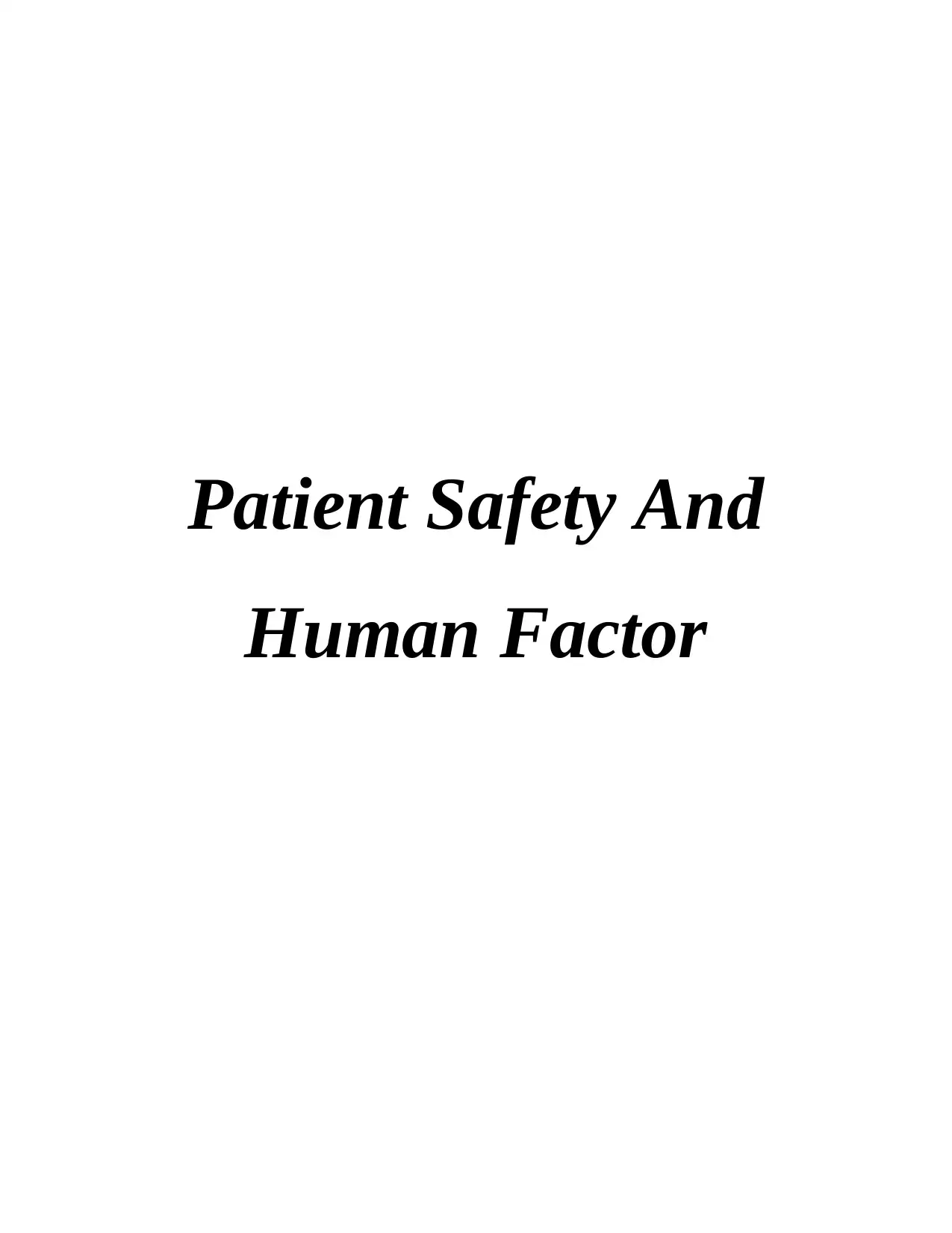
Patient Safety And
Human Factor
Human Factor
Paraphrase This Document
Need a fresh take? Get an instant paraphrase of this document with our AI Paraphraser
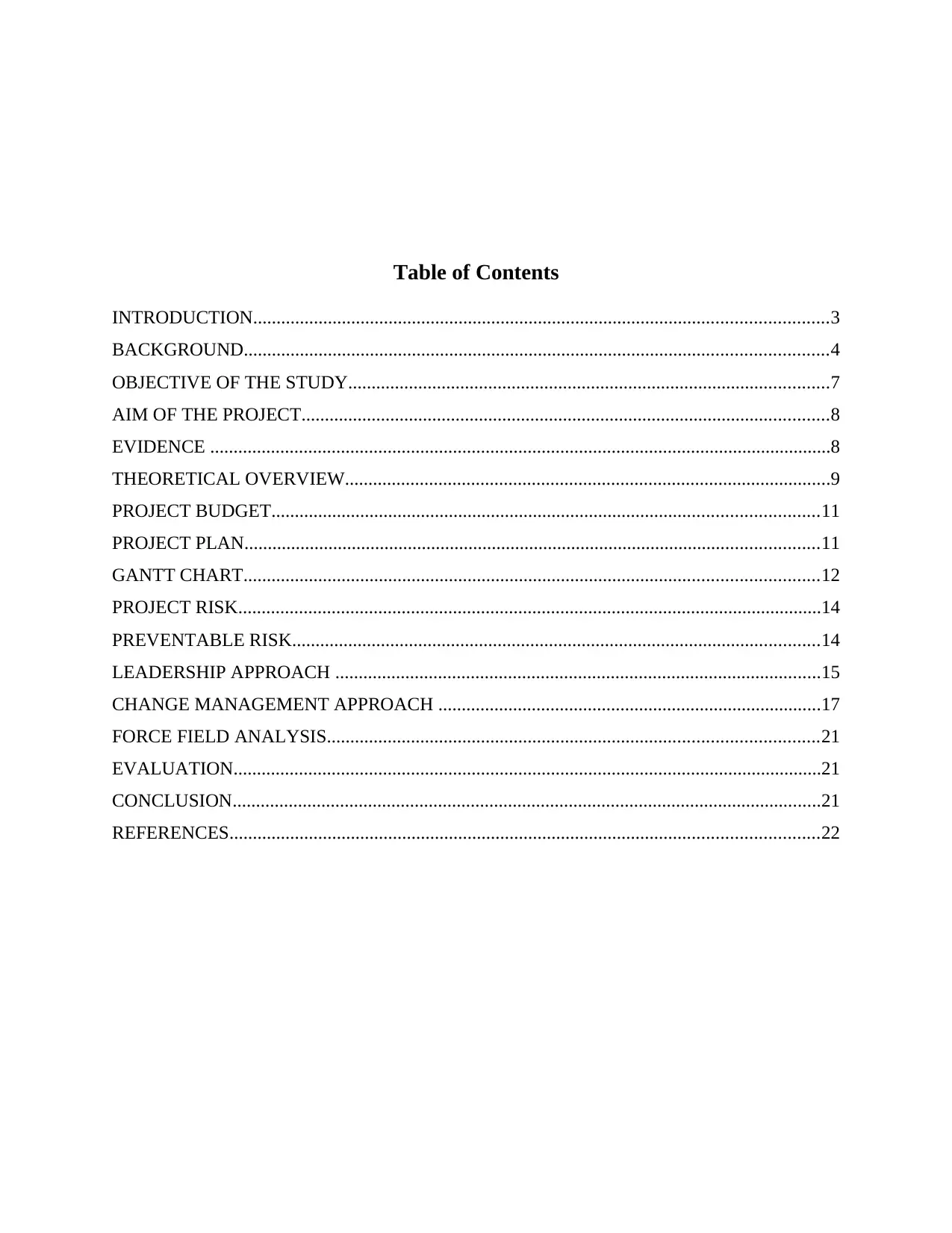
Table of Contents
INTRODUCTION...........................................................................................................................3
BACKGROUND.............................................................................................................................4
OBJECTIVE OF THE STUDY.......................................................................................................7
AIM OF THE PROJECT.................................................................................................................8
EVIDENCE .....................................................................................................................................8
THEORETICAL OVERVIEW........................................................................................................9
PROJECT BUDGET.....................................................................................................................11
PROJECT PLAN...........................................................................................................................11
GANTT CHART...........................................................................................................................12
PROJECT RISK.............................................................................................................................14
PREVENTABLE RISK.................................................................................................................14
LEADERSHIP APPROACH ........................................................................................................15
CHANGE MANAGEMENT APPROACH ..................................................................................17
FORCE FIELD ANALYSIS.........................................................................................................21
EVALUATION..............................................................................................................................21
CONCLUSION..............................................................................................................................21
REFERENCES..............................................................................................................................22
INTRODUCTION...........................................................................................................................3
BACKGROUND.............................................................................................................................4
OBJECTIVE OF THE STUDY.......................................................................................................7
AIM OF THE PROJECT.................................................................................................................8
EVIDENCE .....................................................................................................................................8
THEORETICAL OVERVIEW........................................................................................................9
PROJECT BUDGET.....................................................................................................................11
PROJECT PLAN...........................................................................................................................11
GANTT CHART...........................................................................................................................12
PROJECT RISK.............................................................................................................................14
PREVENTABLE RISK.................................................................................................................14
LEADERSHIP APPROACH ........................................................................................................15
CHANGE MANAGEMENT APPROACH ..................................................................................17
FORCE FIELD ANALYSIS.........................................................................................................21
EVALUATION..............................................................................................................................21
CONCLUSION..............................................................................................................................21
REFERENCES..............................................................................................................................22
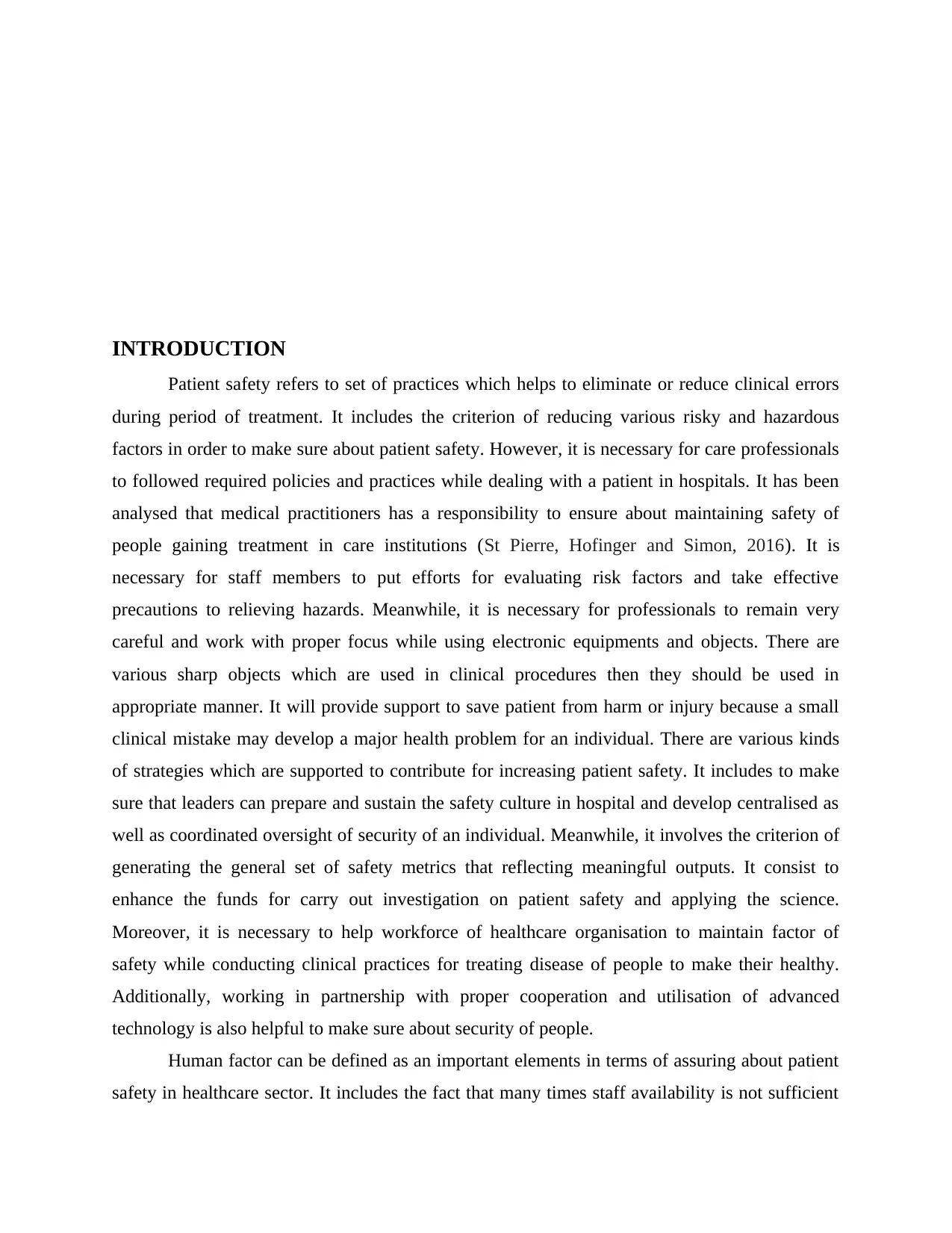
INTRODUCTION
Patient safety refers to set of practices which helps to eliminate or reduce clinical errors
during period of treatment. It includes the criterion of reducing various risky and hazardous
factors in order to make sure about patient safety. However, it is necessary for care professionals
to followed required policies and practices while dealing with a patient in hospitals. It has been
analysed that medical practitioners has a responsibility to ensure about maintaining safety of
people gaining treatment in care institutions (St Pierre, Hofinger and Simon, 2016). It is
necessary for staff members to put efforts for evaluating risk factors and take effective
precautions to relieving hazards. Meanwhile, it is necessary for professionals to remain very
careful and work with proper focus while using electronic equipments and objects. There are
various sharp objects which are used in clinical procedures then they should be used in
appropriate manner. It will provide support to save patient from harm or injury because a small
clinical mistake may develop a major health problem for an individual. There are various kinds
of strategies which are supported to contribute for increasing patient safety. It includes to make
sure that leaders can prepare and sustain the safety culture in hospital and develop centralised as
well as coordinated oversight of security of an individual. Meanwhile, it involves the criterion of
generating the general set of safety metrics that reflecting meaningful outputs. It consist to
enhance the funds for carry out investigation on patient safety and applying the science.
Moreover, it is necessary to help workforce of healthcare organisation to maintain factor of
safety while conducting clinical practices for treating disease of people to make their healthy.
Additionally, working in partnership with proper cooperation and utilisation of advanced
technology is also helpful to make sure about security of people.
Human factor can be defined as an important elements in terms of assuring about patient
safety in healthcare sector. It includes the fact that many times staff availability is not sufficient
Patient safety refers to set of practices which helps to eliminate or reduce clinical errors
during period of treatment. It includes the criterion of reducing various risky and hazardous
factors in order to make sure about patient safety. However, it is necessary for care professionals
to followed required policies and practices while dealing with a patient in hospitals. It has been
analysed that medical practitioners has a responsibility to ensure about maintaining safety of
people gaining treatment in care institutions (St Pierre, Hofinger and Simon, 2016). It is
necessary for staff members to put efforts for evaluating risk factors and take effective
precautions to relieving hazards. Meanwhile, it is necessary for professionals to remain very
careful and work with proper focus while using electronic equipments and objects. There are
various sharp objects which are used in clinical procedures then they should be used in
appropriate manner. It will provide support to save patient from harm or injury because a small
clinical mistake may develop a major health problem for an individual. There are various kinds
of strategies which are supported to contribute for increasing patient safety. It includes to make
sure that leaders can prepare and sustain the safety culture in hospital and develop centralised as
well as coordinated oversight of security of an individual. Meanwhile, it involves the criterion of
generating the general set of safety metrics that reflecting meaningful outputs. It consist to
enhance the funds for carry out investigation on patient safety and applying the science.
Moreover, it is necessary to help workforce of healthcare organisation to maintain factor of
safety while conducting clinical practices for treating disease of people to make their healthy.
Additionally, working in partnership with proper cooperation and utilisation of advanced
technology is also helpful to make sure about security of people.
Human factor can be defined as an important elements in terms of assuring about patient
safety in healthcare sector. It includes the fact that many times staff availability is not sufficient
⊘ This is a preview!⊘
Do you want full access?
Subscribe today to unlock all pages.

Trusted by 1+ million students worldwide
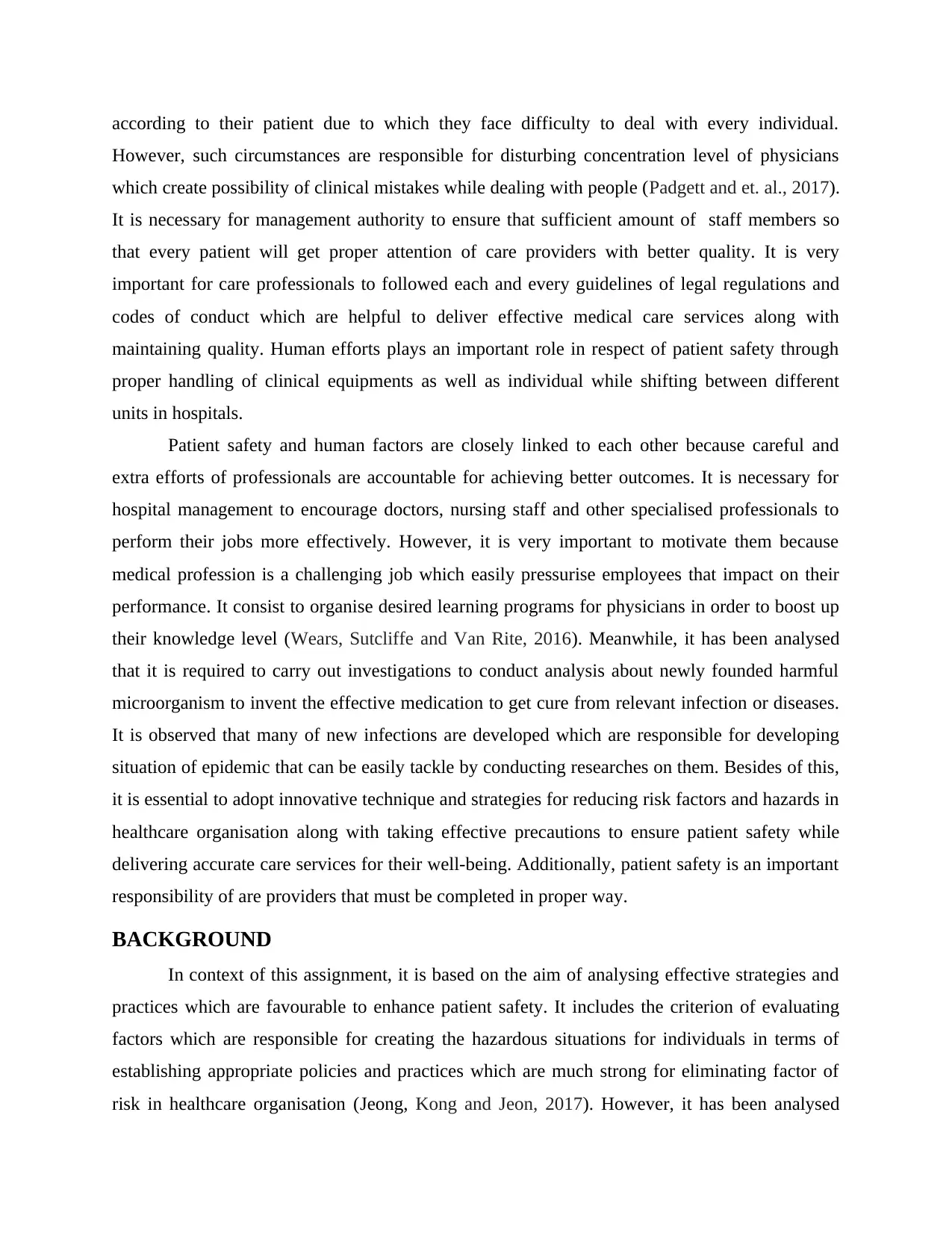
according to their patient due to which they face difficulty to deal with every individual.
However, such circumstances are responsible for disturbing concentration level of physicians
which create possibility of clinical mistakes while dealing with people (Padgett and et. al., 2017).
It is necessary for management authority to ensure that sufficient amount of staff members so
that every patient will get proper attention of care providers with better quality. It is very
important for care professionals to followed each and every guidelines of legal regulations and
codes of conduct which are helpful to deliver effective medical care services along with
maintaining quality. Human efforts plays an important role in respect of patient safety through
proper handling of clinical equipments as well as individual while shifting between different
units in hospitals.
Patient safety and human factors are closely linked to each other because careful and
extra efforts of professionals are accountable for achieving better outcomes. It is necessary for
hospital management to encourage doctors, nursing staff and other specialised professionals to
perform their jobs more effectively. However, it is very important to motivate them because
medical profession is a challenging job which easily pressurise employees that impact on their
performance. It consist to organise desired learning programs for physicians in order to boost up
their knowledge level (Wears, Sutcliffe and Van Rite, 2016). Meanwhile, it has been analysed
that it is required to carry out investigations to conduct analysis about newly founded harmful
microorganism to invent the effective medication to get cure from relevant infection or diseases.
It is observed that many of new infections are developed which are responsible for developing
situation of epidemic that can be easily tackle by conducting researches on them. Besides of this,
it is essential to adopt innovative technique and strategies for reducing risk factors and hazards in
healthcare organisation along with taking effective precautions to ensure patient safety while
delivering accurate care services for their well-being. Additionally, patient safety is an important
responsibility of are providers that must be completed in proper way.
BACKGROUND
In context of this assignment, it is based on the aim of analysing effective strategies and
practices which are favourable to enhance patient safety. It includes the criterion of evaluating
factors which are responsible for creating the hazardous situations for individuals in terms of
establishing appropriate policies and practices which are much strong for eliminating factor of
risk in healthcare organisation (Jeong, Kong and Jeon, 2017). However, it has been analysed
However, such circumstances are responsible for disturbing concentration level of physicians
which create possibility of clinical mistakes while dealing with people (Padgett and et. al., 2017).
It is necessary for management authority to ensure that sufficient amount of staff members so
that every patient will get proper attention of care providers with better quality. It is very
important for care professionals to followed each and every guidelines of legal regulations and
codes of conduct which are helpful to deliver effective medical care services along with
maintaining quality. Human efforts plays an important role in respect of patient safety through
proper handling of clinical equipments as well as individual while shifting between different
units in hospitals.
Patient safety and human factors are closely linked to each other because careful and
extra efforts of professionals are accountable for achieving better outcomes. It is necessary for
hospital management to encourage doctors, nursing staff and other specialised professionals to
perform their jobs more effectively. However, it is very important to motivate them because
medical profession is a challenging job which easily pressurise employees that impact on their
performance. It consist to organise desired learning programs for physicians in order to boost up
their knowledge level (Wears, Sutcliffe and Van Rite, 2016). Meanwhile, it has been analysed
that it is required to carry out investigations to conduct analysis about newly founded harmful
microorganism to invent the effective medication to get cure from relevant infection or diseases.
It is observed that many of new infections are developed which are responsible for developing
situation of epidemic that can be easily tackle by conducting researches on them. Besides of this,
it is essential to adopt innovative technique and strategies for reducing risk factors and hazards in
healthcare organisation along with taking effective precautions to ensure patient safety while
delivering accurate care services for their well-being. Additionally, patient safety is an important
responsibility of are providers that must be completed in proper way.
BACKGROUND
In context of this assignment, it is based on the aim of analysing effective strategies and
practices which are favourable to enhance patient safety. It includes the criterion of evaluating
factors which are responsible for creating the hazardous situations for individuals in terms of
establishing appropriate policies and practices which are much strong for eliminating factor of
risk in healthcare organisation (Jeong, Kong and Jeon, 2017). However, it has been analysed
Paraphrase This Document
Need a fresh take? Get an instant paraphrase of this document with our AI Paraphraser
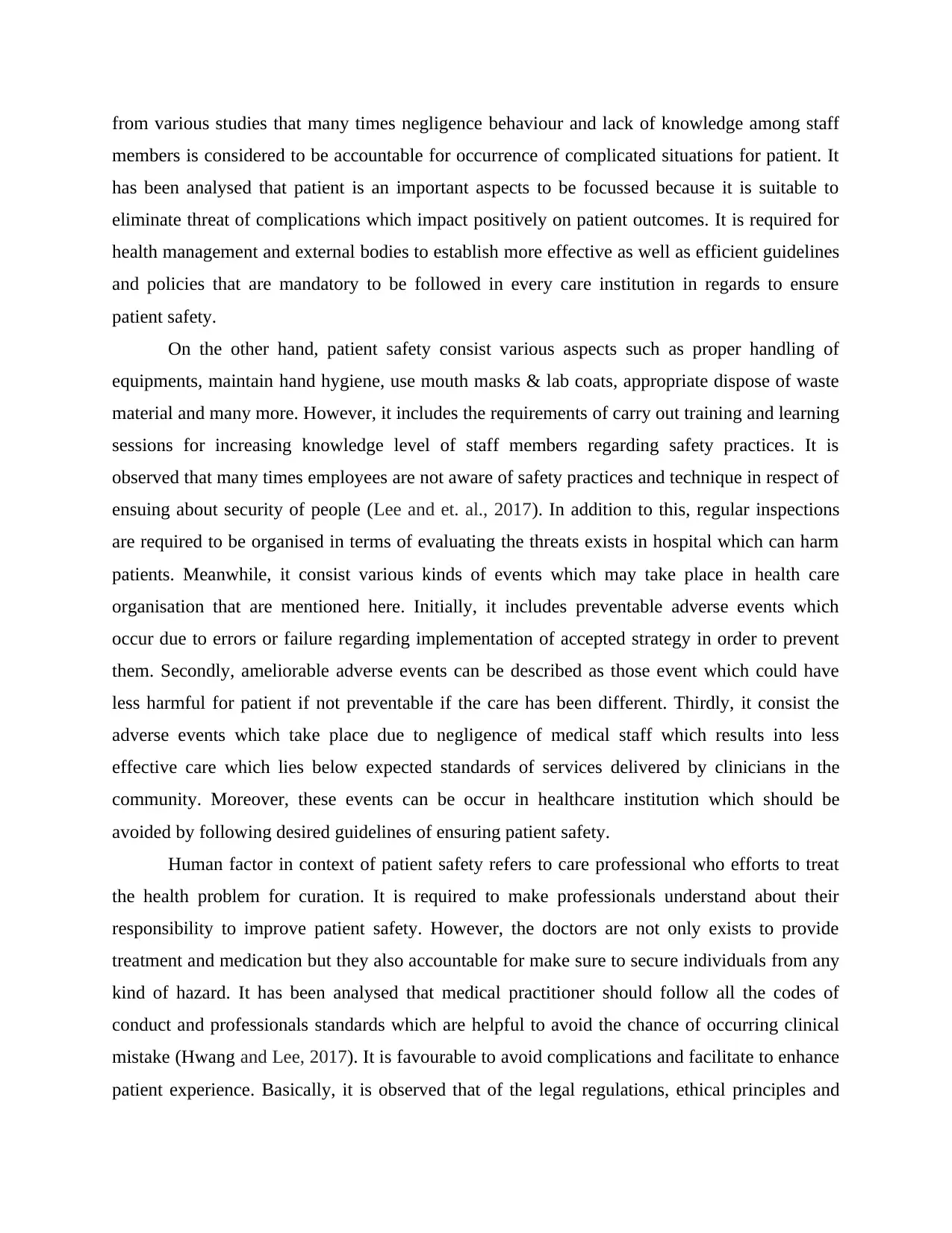
from various studies that many times negligence behaviour and lack of knowledge among staff
members is considered to be accountable for occurrence of complicated situations for patient. It
has been analysed that patient is an important aspects to be focussed because it is suitable to
eliminate threat of complications which impact positively on patient outcomes. It is required for
health management and external bodies to establish more effective as well as efficient guidelines
and policies that are mandatory to be followed in every care institution in regards to ensure
patient safety.
On the other hand, patient safety consist various aspects such as proper handling of
equipments, maintain hand hygiene, use mouth masks & lab coats, appropriate dispose of waste
material and many more. However, it includes the requirements of carry out training and learning
sessions for increasing knowledge level of staff members regarding safety practices. It is
observed that many times employees are not aware of safety practices and technique in respect of
ensuing about security of people (Lee and et. al., 2017). In addition to this, regular inspections
are required to be organised in terms of evaluating the threats exists in hospital which can harm
patients. Meanwhile, it consist various kinds of events which may take place in health care
organisation that are mentioned here. Initially, it includes preventable adverse events which
occur due to errors or failure regarding implementation of accepted strategy in order to prevent
them. Secondly, ameliorable adverse events can be described as those event which could have
less harmful for patient if not preventable if the care has been different. Thirdly, it consist the
adverse events which take place due to negligence of medical staff which results into less
effective care which lies below expected standards of services delivered by clinicians in the
community. Moreover, these events can be occur in healthcare institution which should be
avoided by following desired guidelines of ensuring patient safety.
Human factor in context of patient safety refers to care professional who efforts to treat
the health problem for curation. It is required to make professionals understand about their
responsibility to improve patient safety. However, the doctors are not only exists to provide
treatment and medication but they also accountable for make sure to secure individuals from any
kind of hazard. It has been analysed that medical practitioner should follow all the codes of
conduct and professionals standards which are helpful to avoid the chance of occurring clinical
mistake (Hwang and Lee, 2017). It is favourable to avoid complications and facilitate to enhance
patient experience. Basically, it is observed that of the legal regulations, ethical principles and
members is considered to be accountable for occurrence of complicated situations for patient. It
has been analysed that patient is an important aspects to be focussed because it is suitable to
eliminate threat of complications which impact positively on patient outcomes. It is required for
health management and external bodies to establish more effective as well as efficient guidelines
and policies that are mandatory to be followed in every care institution in regards to ensure
patient safety.
On the other hand, patient safety consist various aspects such as proper handling of
equipments, maintain hand hygiene, use mouth masks & lab coats, appropriate dispose of waste
material and many more. However, it includes the requirements of carry out training and learning
sessions for increasing knowledge level of staff members regarding safety practices. It is
observed that many times employees are not aware of safety practices and technique in respect of
ensuing about security of people (Lee and et. al., 2017). In addition to this, regular inspections
are required to be organised in terms of evaluating the threats exists in hospital which can harm
patients. Meanwhile, it consist various kinds of events which may take place in health care
organisation that are mentioned here. Initially, it includes preventable adverse events which
occur due to errors or failure regarding implementation of accepted strategy in order to prevent
them. Secondly, ameliorable adverse events can be described as those event which could have
less harmful for patient if not preventable if the care has been different. Thirdly, it consist the
adverse events which take place due to negligence of medical staff which results into less
effective care which lies below expected standards of services delivered by clinicians in the
community. Moreover, these events can be occur in healthcare institution which should be
avoided by following desired guidelines of ensuring patient safety.
Human factor in context of patient safety refers to care professional who efforts to treat
the health problem for curation. It is required to make professionals understand about their
responsibility to improve patient safety. However, the doctors are not only exists to provide
treatment and medication but they also accountable for make sure to secure individuals from any
kind of hazard. It has been analysed that medical practitioner should follow all the codes of
conduct and professionals standards which are helpful to avoid the chance of occurring clinical
mistake (Hwang and Lee, 2017). It is favourable to avoid complications and facilitate to enhance
patient experience. Basically, it is observed that of the legal regulations, ethical principles and
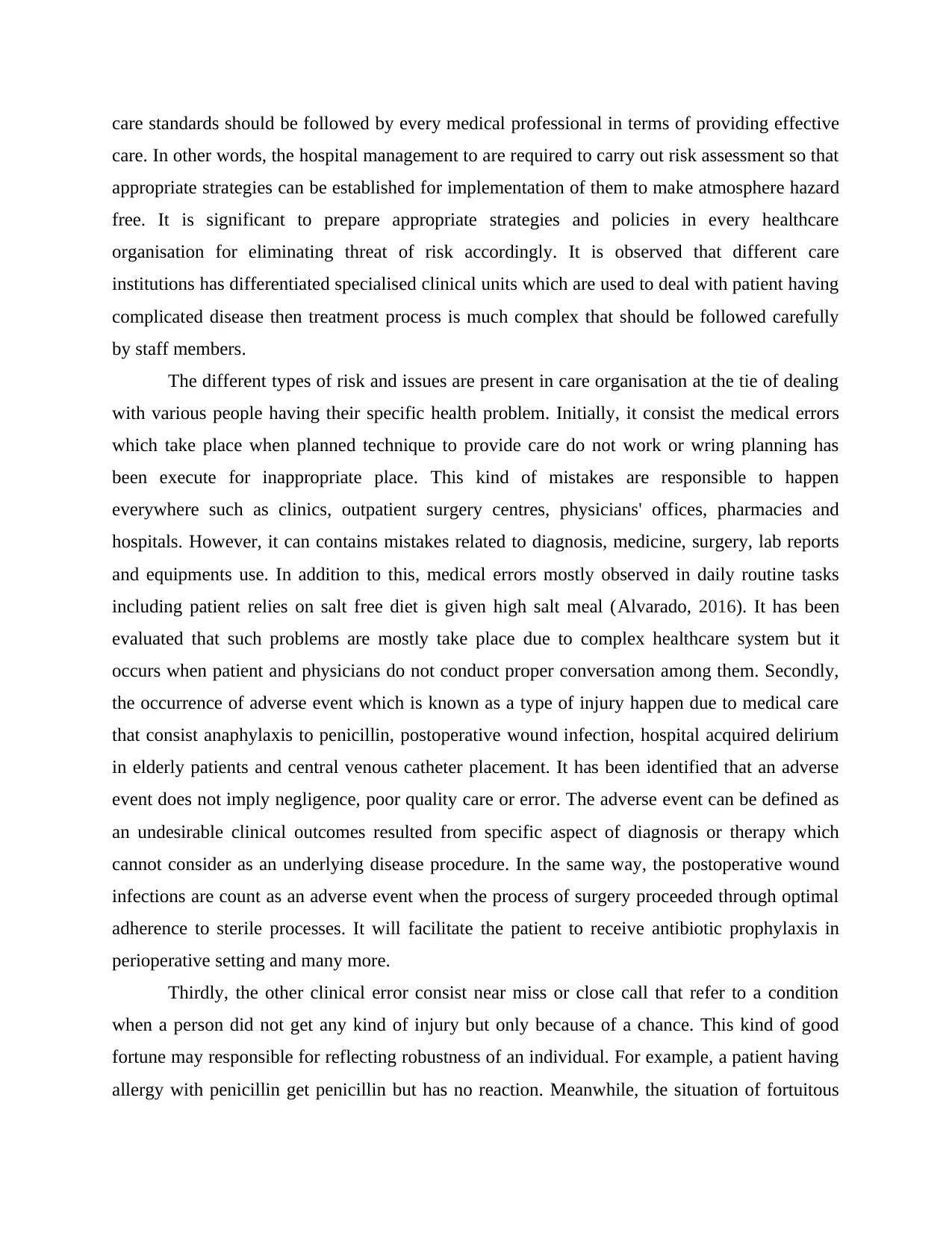
care standards should be followed by every medical professional in terms of providing effective
care. In other words, the hospital management to are required to carry out risk assessment so that
appropriate strategies can be established for implementation of them to make atmosphere hazard
free. It is significant to prepare appropriate strategies and policies in every healthcare
organisation for eliminating threat of risk accordingly. It is observed that different care
institutions has differentiated specialised clinical units which are used to deal with patient having
complicated disease then treatment process is much complex that should be followed carefully
by staff members.
The different types of risk and issues are present in care organisation at the tie of dealing
with various people having their specific health problem. Initially, it consist the medical errors
which take place when planned technique to provide care do not work or wring planning has
been execute for inappropriate place. This kind of mistakes are responsible to happen
everywhere such as clinics, outpatient surgery centres, physicians' offices, pharmacies and
hospitals. However, it can contains mistakes related to diagnosis, medicine, surgery, lab reports
and equipments use. In addition to this, medical errors mostly observed in daily routine tasks
including patient relies on salt free diet is given high salt meal (Alvarado, 2016). It has been
evaluated that such problems are mostly take place due to complex healthcare system but it
occurs when patient and physicians do not conduct proper conversation among them. Secondly,
the occurrence of adverse event which is known as a type of injury happen due to medical care
that consist anaphylaxis to penicillin, postoperative wound infection, hospital acquired delirium
in elderly patients and central venous catheter placement. It has been identified that an adverse
event does not imply negligence, poor quality care or error. The adverse event can be defined as
an undesirable clinical outcomes resulted from specific aspect of diagnosis or therapy which
cannot consider as an underlying disease procedure. In the same way, the postoperative wound
infections are count as an adverse event when the process of surgery proceeded through optimal
adherence to sterile processes. It will facilitate the patient to receive antibiotic prophylaxis in
perioperative setting and many more.
Thirdly, the other clinical error consist near miss or close call that refer to a condition
when a person did not get any kind of injury but only because of a chance. This kind of good
fortune may responsible for reflecting robustness of an individual. For example, a patient having
allergy with penicillin get penicillin but has no reaction. Meanwhile, the situation of fortuitous
care. In other words, the hospital management to are required to carry out risk assessment so that
appropriate strategies can be established for implementation of them to make atmosphere hazard
free. It is significant to prepare appropriate strategies and policies in every healthcare
organisation for eliminating threat of risk accordingly. It is observed that different care
institutions has differentiated specialised clinical units which are used to deal with patient having
complicated disease then treatment process is much complex that should be followed carefully
by staff members.
The different types of risk and issues are present in care organisation at the tie of dealing
with various people having their specific health problem. Initially, it consist the medical errors
which take place when planned technique to provide care do not work or wring planning has
been execute for inappropriate place. This kind of mistakes are responsible to happen
everywhere such as clinics, outpatient surgery centres, physicians' offices, pharmacies and
hospitals. However, it can contains mistakes related to diagnosis, medicine, surgery, lab reports
and equipments use. In addition to this, medical errors mostly observed in daily routine tasks
including patient relies on salt free diet is given high salt meal (Alvarado, 2016). It has been
evaluated that such problems are mostly take place due to complex healthcare system but it
occurs when patient and physicians do not conduct proper conversation among them. Secondly,
the occurrence of adverse event which is known as a type of injury happen due to medical care
that consist anaphylaxis to penicillin, postoperative wound infection, hospital acquired delirium
in elderly patients and central venous catheter placement. It has been identified that an adverse
event does not imply negligence, poor quality care or error. The adverse event can be defined as
an undesirable clinical outcomes resulted from specific aspect of diagnosis or therapy which
cannot consider as an underlying disease procedure. In the same way, the postoperative wound
infections are count as an adverse event when the process of surgery proceeded through optimal
adherence to sterile processes. It will facilitate the patient to receive antibiotic prophylaxis in
perioperative setting and many more.
Thirdly, the other clinical error consist near miss or close call that refer to a condition
when a person did not get any kind of injury but only because of a chance. This kind of good
fortune may responsible for reflecting robustness of an individual. For example, a patient having
allergy with penicillin get penicillin but has no reaction. Meanwhile, the situation of fortuitous
⊘ This is a preview!⊘
Do you want full access?
Subscribe today to unlock all pages.

Trusted by 1+ million students worldwide
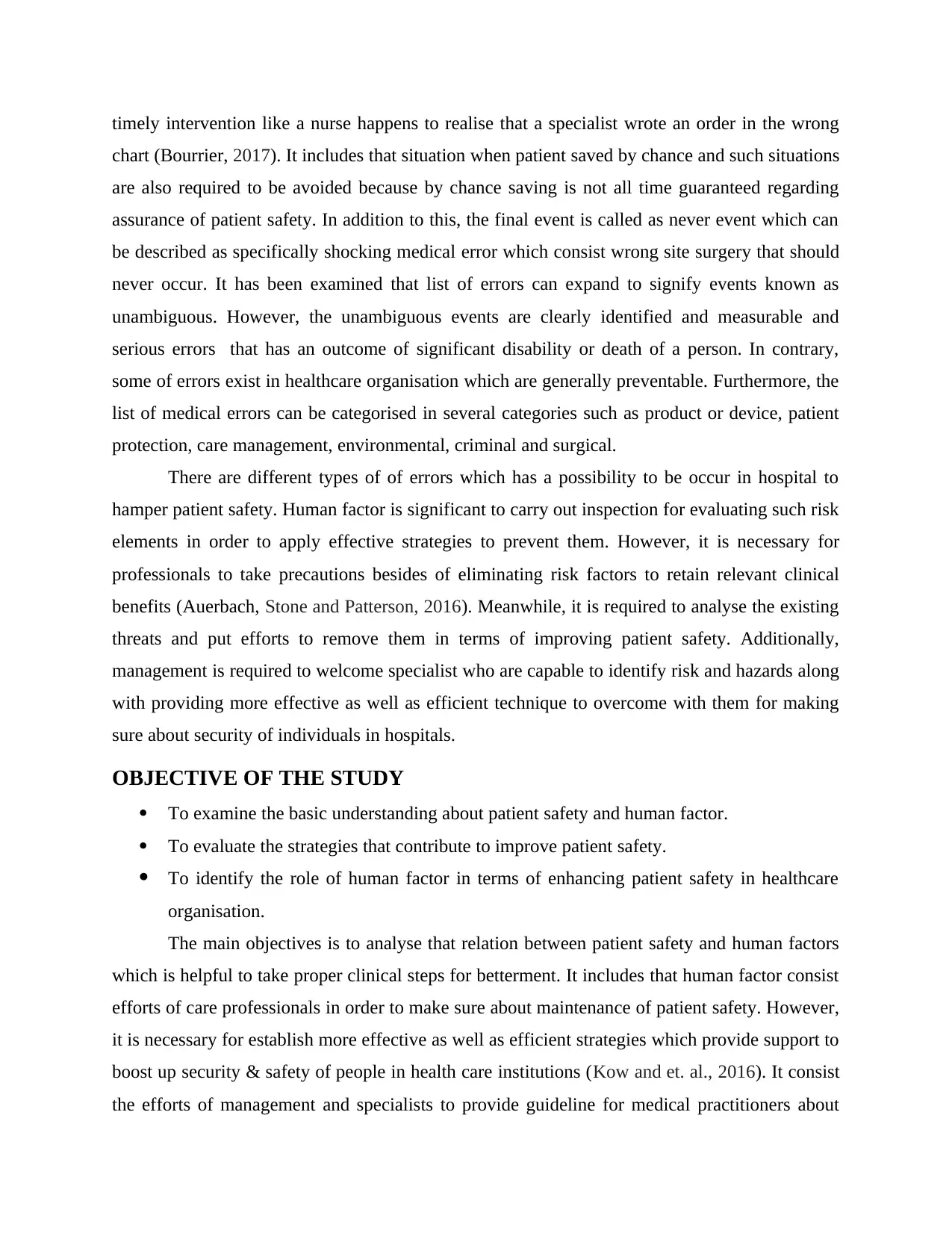
timely intervention like a nurse happens to realise that a specialist wrote an order in the wrong
chart (Bourrier, 2017). It includes that situation when patient saved by chance and such situations
are also required to be avoided because by chance saving is not all time guaranteed regarding
assurance of patient safety. In addition to this, the final event is called as never event which can
be described as specifically shocking medical error which consist wrong site surgery that should
never occur. It has been examined that list of errors can expand to signify events known as
unambiguous. However, the unambiguous events are clearly identified and measurable and
serious errors that has an outcome of significant disability or death of a person. In contrary,
some of errors exist in healthcare organisation which are generally preventable. Furthermore, the
list of medical errors can be categorised in several categories such as product or device, patient
protection, care management, environmental, criminal and surgical.
There are different types of of errors which has a possibility to be occur in hospital to
hamper patient safety. Human factor is significant to carry out inspection for evaluating such risk
elements in order to apply effective strategies to prevent them. However, it is necessary for
professionals to take precautions besides of eliminating risk factors to retain relevant clinical
benefits (Auerbach, Stone and Patterson, 2016). Meanwhile, it is required to analyse the existing
threats and put efforts to remove them in terms of improving patient safety. Additionally,
management is required to welcome specialist who are capable to identify risk and hazards along
with providing more effective as well as efficient technique to overcome with them for making
sure about security of individuals in hospitals.
OBJECTIVE OF THE STUDY
To examine the basic understanding about patient safety and human factor.
To evaluate the strategies that contribute to improve patient safety.
To identify the role of human factor in terms of enhancing patient safety in healthcare
organisation.
The main objectives is to analyse that relation between patient safety and human factors
which is helpful to take proper clinical steps for betterment. It includes that human factor consist
efforts of care professionals in order to make sure about maintenance of patient safety. However,
it is necessary for establish more effective as well as efficient strategies which provide support to
boost up security & safety of people in health care institutions (Kow and et. al., 2016). It consist
the efforts of management and specialists to provide guideline for medical practitioners about
chart (Bourrier, 2017). It includes that situation when patient saved by chance and such situations
are also required to be avoided because by chance saving is not all time guaranteed regarding
assurance of patient safety. In addition to this, the final event is called as never event which can
be described as specifically shocking medical error which consist wrong site surgery that should
never occur. It has been examined that list of errors can expand to signify events known as
unambiguous. However, the unambiguous events are clearly identified and measurable and
serious errors that has an outcome of significant disability or death of a person. In contrary,
some of errors exist in healthcare organisation which are generally preventable. Furthermore, the
list of medical errors can be categorised in several categories such as product or device, patient
protection, care management, environmental, criminal and surgical.
There are different types of of errors which has a possibility to be occur in hospital to
hamper patient safety. Human factor is significant to carry out inspection for evaluating such risk
elements in order to apply effective strategies to prevent them. However, it is necessary for
professionals to take precautions besides of eliminating risk factors to retain relevant clinical
benefits (Auerbach, Stone and Patterson, 2016). Meanwhile, it is required to analyse the existing
threats and put efforts to remove them in terms of improving patient safety. Additionally,
management is required to welcome specialist who are capable to identify risk and hazards along
with providing more effective as well as efficient technique to overcome with them for making
sure about security of individuals in hospitals.
OBJECTIVE OF THE STUDY
To examine the basic understanding about patient safety and human factor.
To evaluate the strategies that contribute to improve patient safety.
To identify the role of human factor in terms of enhancing patient safety in healthcare
organisation.
The main objectives is to analyse that relation between patient safety and human factors
which is helpful to take proper clinical steps for betterment. It includes that human factor consist
efforts of care professionals in order to make sure about maintenance of patient safety. However,
it is necessary for establish more effective as well as efficient strategies which provide support to
boost up security & safety of people in health care institutions (Kow and et. al., 2016). It consist
the efforts of management and specialists to provide guideline for medical practitioners about
Paraphrase This Document
Need a fresh take? Get an instant paraphrase of this document with our AI Paraphraser
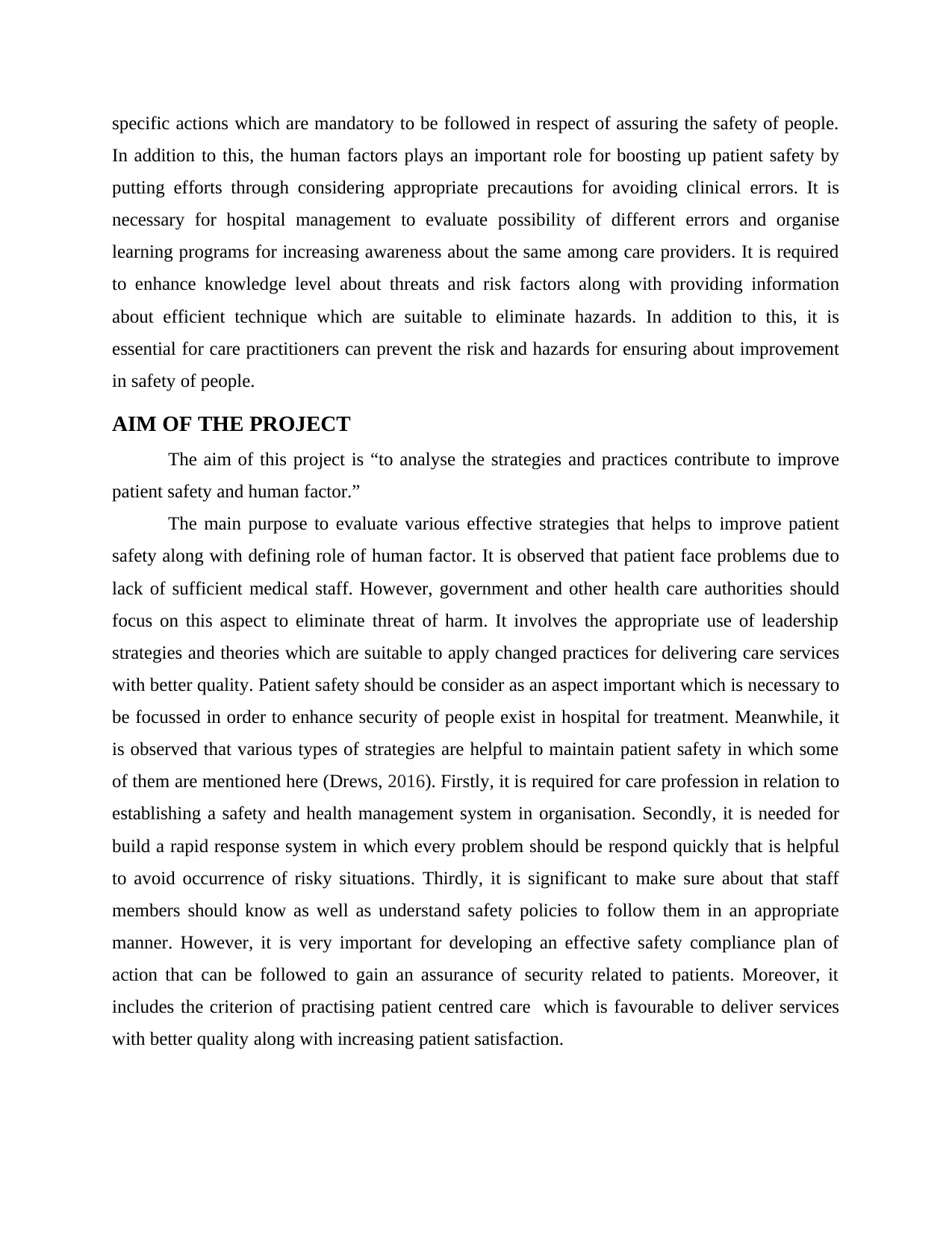
specific actions which are mandatory to be followed in respect of assuring the safety of people.
In addition to this, the human factors plays an important role for boosting up patient safety by
putting efforts through considering appropriate precautions for avoiding clinical errors. It is
necessary for hospital management to evaluate possibility of different errors and organise
learning programs for increasing awareness about the same among care providers. It is required
to enhance knowledge level about threats and risk factors along with providing information
about efficient technique which are suitable to eliminate hazards. In addition to this, it is
essential for care practitioners can prevent the risk and hazards for ensuring about improvement
in safety of people.
AIM OF THE PROJECT
The aim of this project is “to analyse the strategies and practices contribute to improve
patient safety and human factor.”
The main purpose to evaluate various effective strategies that helps to improve patient
safety along with defining role of human factor. It is observed that patient face problems due to
lack of sufficient medical staff. However, government and other health care authorities should
focus on this aspect to eliminate threat of harm. It involves the appropriate use of leadership
strategies and theories which are suitable to apply changed practices for delivering care services
with better quality. Patient safety should be consider as an aspect important which is necessary to
be focussed in order to enhance security of people exist in hospital for treatment. Meanwhile, it
is observed that various types of strategies are helpful to maintain patient safety in which some
of them are mentioned here (Drews, 2016). Firstly, it is required for care profession in relation to
establishing a safety and health management system in organisation. Secondly, it is needed for
build a rapid response system in which every problem should be respond quickly that is helpful
to avoid occurrence of risky situations. Thirdly, it is significant to make sure about that staff
members should know as well as understand safety policies to follow them in an appropriate
manner. However, it is very important for developing an effective safety compliance plan of
action that can be followed to gain an assurance of security related to patients. Moreover, it
includes the criterion of practising patient centred care which is favourable to deliver services
with better quality along with increasing patient satisfaction.
In addition to this, the human factors plays an important role for boosting up patient safety by
putting efforts through considering appropriate precautions for avoiding clinical errors. It is
necessary for hospital management to evaluate possibility of different errors and organise
learning programs for increasing awareness about the same among care providers. It is required
to enhance knowledge level about threats and risk factors along with providing information
about efficient technique which are suitable to eliminate hazards. In addition to this, it is
essential for care practitioners can prevent the risk and hazards for ensuring about improvement
in safety of people.
AIM OF THE PROJECT
The aim of this project is “to analyse the strategies and practices contribute to improve
patient safety and human factor.”
The main purpose to evaluate various effective strategies that helps to improve patient
safety along with defining role of human factor. It is observed that patient face problems due to
lack of sufficient medical staff. However, government and other health care authorities should
focus on this aspect to eliminate threat of harm. It involves the appropriate use of leadership
strategies and theories which are suitable to apply changed practices for delivering care services
with better quality. Patient safety should be consider as an aspect important which is necessary to
be focussed in order to enhance security of people exist in hospital for treatment. Meanwhile, it
is observed that various types of strategies are helpful to maintain patient safety in which some
of them are mentioned here (Drews, 2016). Firstly, it is required for care profession in relation to
establishing a safety and health management system in organisation. Secondly, it is needed for
build a rapid response system in which every problem should be respond quickly that is helpful
to avoid occurrence of risky situations. Thirdly, it is significant to make sure about that staff
members should know as well as understand safety policies to follow them in an appropriate
manner. However, it is very important for developing an effective safety compliance plan of
action that can be followed to gain an assurance of security related to patients. Moreover, it
includes the criterion of practising patient centred care which is favourable to deliver services
with better quality along with increasing patient satisfaction.
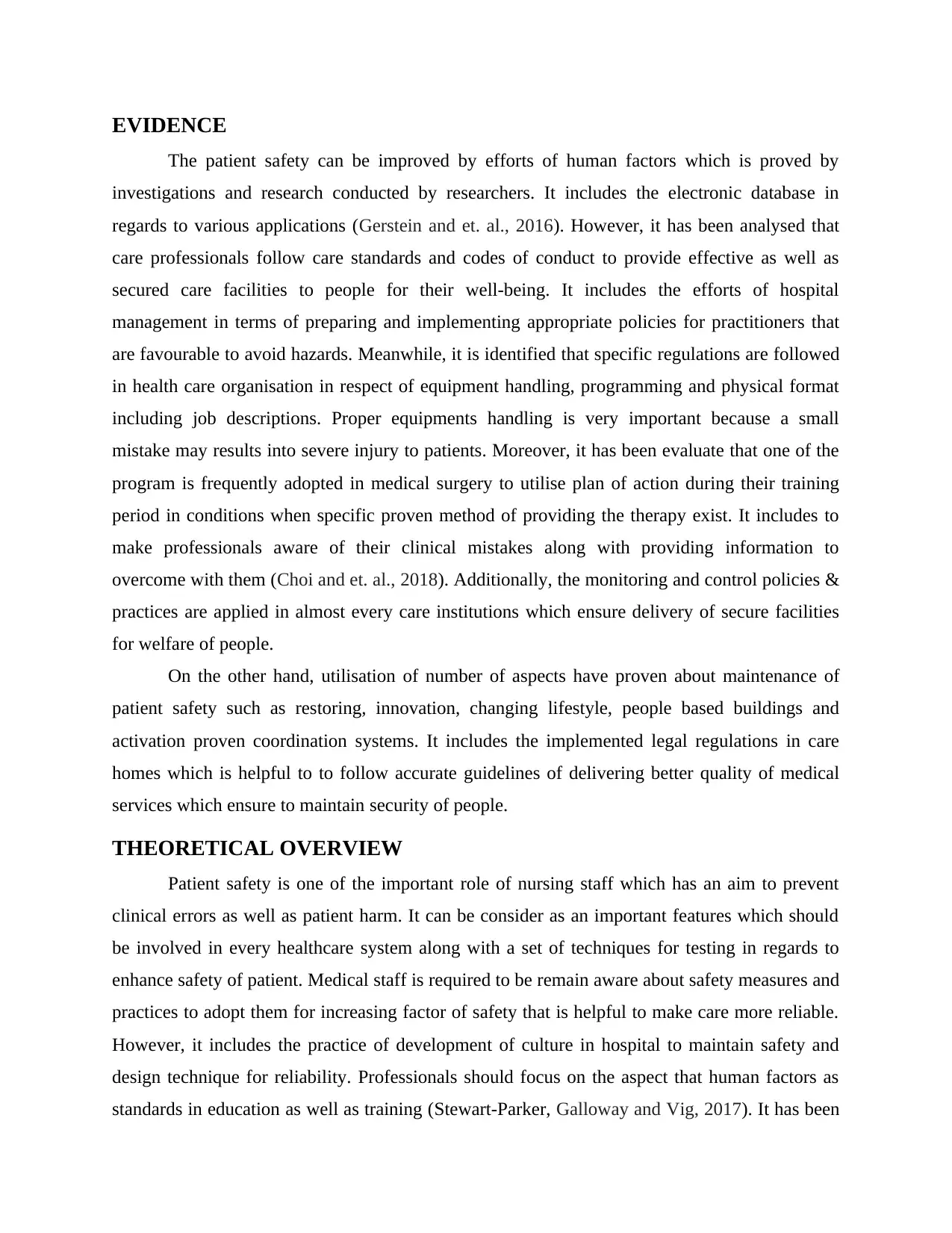
EVIDENCE
The patient safety can be improved by efforts of human factors which is proved by
investigations and research conducted by researchers. It includes the electronic database in
regards to various applications (Gerstein and et. al., 2016). However, it has been analysed that
care professionals follow care standards and codes of conduct to provide effective as well as
secured care facilities to people for their well-being. It includes the efforts of hospital
management in terms of preparing and implementing appropriate policies for practitioners that
are favourable to avoid hazards. Meanwhile, it is identified that specific regulations are followed
in health care organisation in respect of equipment handling, programming and physical format
including job descriptions. Proper equipments handling is very important because a small
mistake may results into severe injury to patients. Moreover, it has been evaluate that one of the
program is frequently adopted in medical surgery to utilise plan of action during their training
period in conditions when specific proven method of providing the therapy exist. It includes to
make professionals aware of their clinical mistakes along with providing information to
overcome with them (Choi and et. al., 2018). Additionally, the monitoring and control policies &
practices are applied in almost every care institutions which ensure delivery of secure facilities
for welfare of people.
On the other hand, utilisation of number of aspects have proven about maintenance of
patient safety such as restoring, innovation, changing lifestyle, people based buildings and
activation proven coordination systems. It includes the implemented legal regulations in care
homes which is helpful to to follow accurate guidelines of delivering better quality of medical
services which ensure to maintain security of people.
THEORETICAL OVERVIEW
Patient safety is one of the important role of nursing staff which has an aim to prevent
clinical errors as well as patient harm. It can be consider as an important features which should
be involved in every healthcare system along with a set of techniques for testing in regards to
enhance safety of patient. Medical staff is required to be remain aware about safety measures and
practices to adopt them for increasing factor of safety that is helpful to make care more reliable.
However, it includes the practice of development of culture in hospital to maintain safety and
design technique for reliability. Professionals should focus on the aspect that human factors as
standards in education as well as training (Stewart-Parker, Galloway and Vig, 2017). It has been
The patient safety can be improved by efforts of human factors which is proved by
investigations and research conducted by researchers. It includes the electronic database in
regards to various applications (Gerstein and et. al., 2016). However, it has been analysed that
care professionals follow care standards and codes of conduct to provide effective as well as
secured care facilities to people for their well-being. It includes the efforts of hospital
management in terms of preparing and implementing appropriate policies for practitioners that
are favourable to avoid hazards. Meanwhile, it is identified that specific regulations are followed
in health care organisation in respect of equipment handling, programming and physical format
including job descriptions. Proper equipments handling is very important because a small
mistake may results into severe injury to patients. Moreover, it has been evaluate that one of the
program is frequently adopted in medical surgery to utilise plan of action during their training
period in conditions when specific proven method of providing the therapy exist. It includes to
make professionals aware of their clinical mistakes along with providing information to
overcome with them (Choi and et. al., 2018). Additionally, the monitoring and control policies &
practices are applied in almost every care institutions which ensure delivery of secure facilities
for welfare of people.
On the other hand, utilisation of number of aspects have proven about maintenance of
patient safety such as restoring, innovation, changing lifestyle, people based buildings and
activation proven coordination systems. It includes the implemented legal regulations in care
homes which is helpful to to follow accurate guidelines of delivering better quality of medical
services which ensure to maintain security of people.
THEORETICAL OVERVIEW
Patient safety is one of the important role of nursing staff which has an aim to prevent
clinical errors as well as patient harm. It can be consider as an important features which should
be involved in every healthcare system along with a set of techniques for testing in regards to
enhance safety of patient. Medical staff is required to be remain aware about safety measures and
practices to adopt them for increasing factor of safety that is helpful to make care more reliable.
However, it includes the practice of development of culture in hospital to maintain safety and
design technique for reliability. Professionals should focus on the aspect that human factors as
standards in education as well as training (Stewart-Parker, Galloway and Vig, 2017). It has been
⊘ This is a preview!⊘
Do you want full access?
Subscribe today to unlock all pages.

Trusted by 1+ million students worldwide
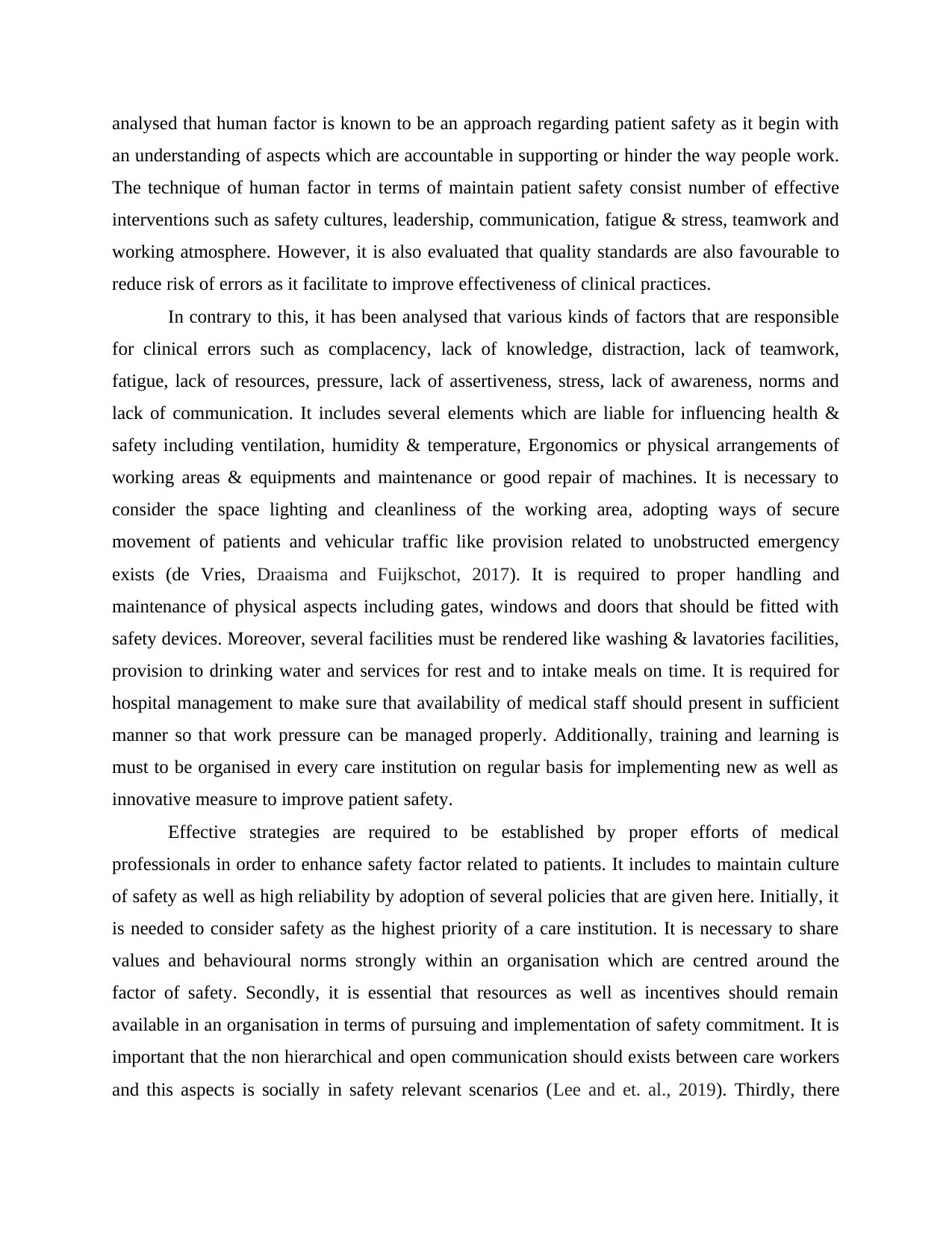
analysed that human factor is known to be an approach regarding patient safety as it begin with
an understanding of aspects which are accountable in supporting or hinder the way people work.
The technique of human factor in terms of maintain patient safety consist number of effective
interventions such as safety cultures, leadership, communication, fatigue & stress, teamwork and
working atmosphere. However, it is also evaluated that quality standards are also favourable to
reduce risk of errors as it facilitate to improve effectiveness of clinical practices.
In contrary to this, it has been analysed that various kinds of factors that are responsible
for clinical errors such as complacency, lack of knowledge, distraction, lack of teamwork,
fatigue, lack of resources, pressure, lack of assertiveness, stress, lack of awareness, norms and
lack of communication. It includes several elements which are liable for influencing health &
safety including ventilation, humidity & temperature, Ergonomics or physical arrangements of
working areas & equipments and maintenance or good repair of machines. It is necessary to
consider the space lighting and cleanliness of the working area, adopting ways of secure
movement of patients and vehicular traffic like provision related to unobstructed emergency
exists (de Vries, Draaisma and Fuijkschot, 2017). It is required to proper handling and
maintenance of physical aspects including gates, windows and doors that should be fitted with
safety devices. Moreover, several facilities must be rendered like washing & lavatories facilities,
provision to drinking water and services for rest and to intake meals on time. It is required for
hospital management to make sure that availability of medical staff should present in sufficient
manner so that work pressure can be managed properly. Additionally, training and learning is
must to be organised in every care institution on regular basis for implementing new as well as
innovative measure to improve patient safety.
Effective strategies are required to be established by proper efforts of medical
professionals in order to enhance safety factor related to patients. It includes to maintain culture
of safety as well as high reliability by adoption of several policies that are given here. Initially, it
is needed to consider safety as the highest priority of a care institution. It is necessary to share
values and behavioural norms strongly within an organisation which are centred around the
factor of safety. Secondly, it is essential that resources as well as incentives should remain
available in an organisation in terms of pursuing and implementation of safety commitment. It is
important that the non hierarchical and open communication should exists between care workers
and this aspects is socially in safety relevant scenarios (Lee and et. al., 2019). Thirdly, there
an understanding of aspects which are accountable in supporting or hinder the way people work.
The technique of human factor in terms of maintain patient safety consist number of effective
interventions such as safety cultures, leadership, communication, fatigue & stress, teamwork and
working atmosphere. However, it is also evaluated that quality standards are also favourable to
reduce risk of errors as it facilitate to improve effectiveness of clinical practices.
In contrary to this, it has been analysed that various kinds of factors that are responsible
for clinical errors such as complacency, lack of knowledge, distraction, lack of teamwork,
fatigue, lack of resources, pressure, lack of assertiveness, stress, lack of awareness, norms and
lack of communication. It includes several elements which are liable for influencing health &
safety including ventilation, humidity & temperature, Ergonomics or physical arrangements of
working areas & equipments and maintenance or good repair of machines. It is necessary to
consider the space lighting and cleanliness of the working area, adopting ways of secure
movement of patients and vehicular traffic like provision related to unobstructed emergency
exists (de Vries, Draaisma and Fuijkschot, 2017). It is required to proper handling and
maintenance of physical aspects including gates, windows and doors that should be fitted with
safety devices. Moreover, several facilities must be rendered like washing & lavatories facilities,
provision to drinking water and services for rest and to intake meals on time. It is required for
hospital management to make sure that availability of medical staff should present in sufficient
manner so that work pressure can be managed properly. Additionally, training and learning is
must to be organised in every care institution on regular basis for implementing new as well as
innovative measure to improve patient safety.
Effective strategies are required to be established by proper efforts of medical
professionals in order to enhance safety factor related to patients. It includes to maintain culture
of safety as well as high reliability by adoption of several policies that are given here. Initially, it
is needed to consider safety as the highest priority of a care institution. It is necessary to share
values and behavioural norms strongly within an organisation which are centred around the
factor of safety. Secondly, it is essential that resources as well as incentives should remain
available in an organisation in terms of pursuing and implementation of safety commitment. It is
important that the non hierarchical and open communication should exists between care workers
and this aspects is socially in safety relevant scenarios (Lee and et. al., 2019). Thirdly, there
Paraphrase This Document
Need a fresh take? Get an instant paraphrase of this document with our AI Paraphraser
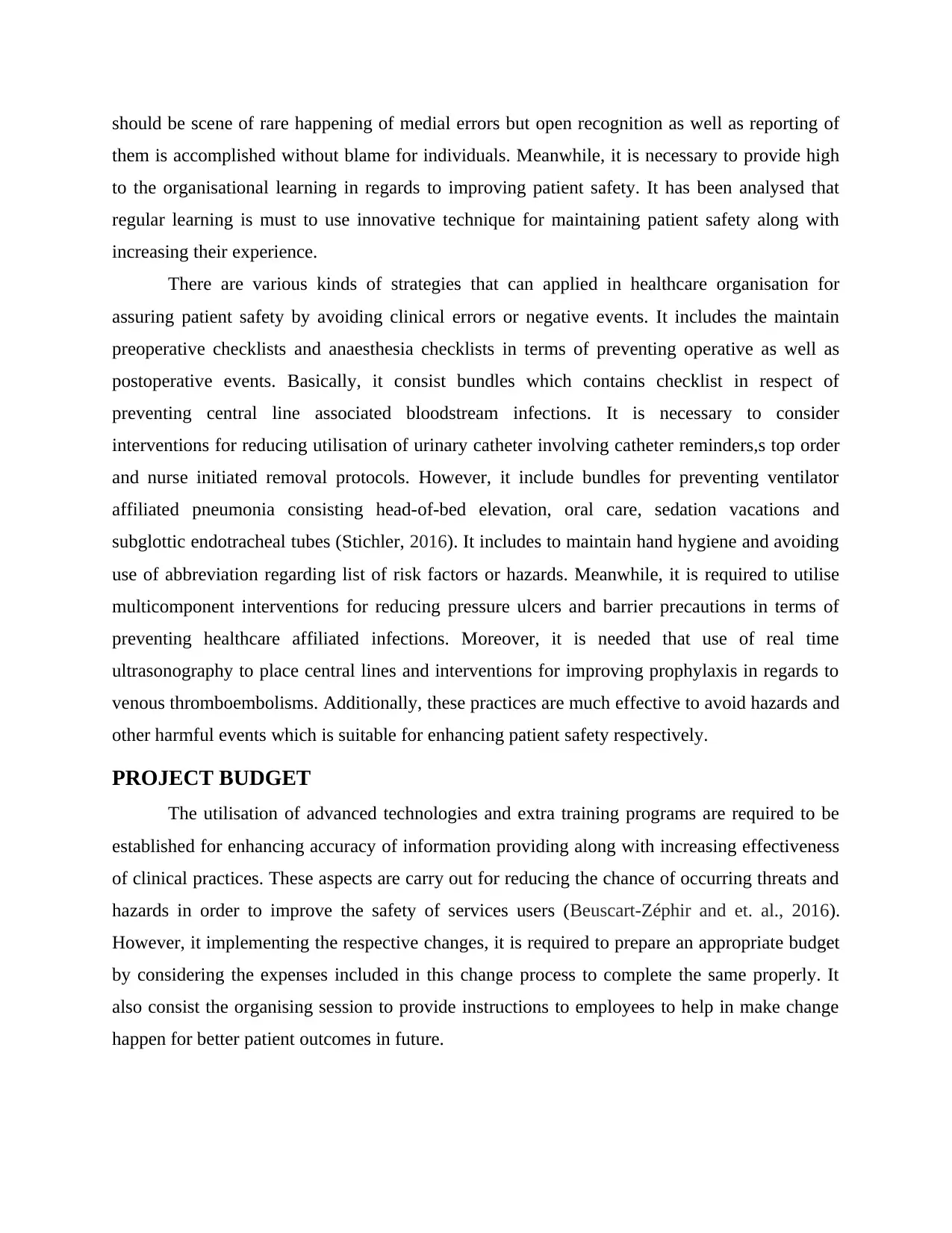
should be scene of rare happening of medial errors but open recognition as well as reporting of
them is accomplished without blame for individuals. Meanwhile, it is necessary to provide high
to the organisational learning in regards to improving patient safety. It has been analysed that
regular learning is must to use innovative technique for maintaining patient safety along with
increasing their experience.
There are various kinds of strategies that can applied in healthcare organisation for
assuring patient safety by avoiding clinical errors or negative events. It includes the maintain
preoperative checklists and anaesthesia checklists in terms of preventing operative as well as
postoperative events. Basically, it consist bundles which contains checklist in respect of
preventing central line associated bloodstream infections. It is necessary to consider
interventions for reducing utilisation of urinary catheter involving catheter reminders,s top order
and nurse initiated removal protocols. However, it include bundles for preventing ventilator
affiliated pneumonia consisting head-of-bed elevation, oral care, sedation vacations and
subglottic endotracheal tubes (Stichler, 2016). It includes to maintain hand hygiene and avoiding
use of abbreviation regarding list of risk factors or hazards. Meanwhile, it is required to utilise
multicomponent interventions for reducing pressure ulcers and barrier precautions in terms of
preventing healthcare affiliated infections. Moreover, it is needed that use of real time
ultrasonography to place central lines and interventions for improving prophylaxis in regards to
venous thromboembolisms. Additionally, these practices are much effective to avoid hazards and
other harmful events which is suitable for enhancing patient safety respectively.
PROJECT BUDGET
The utilisation of advanced technologies and extra training programs are required to be
established for enhancing accuracy of information providing along with increasing effectiveness
of clinical practices. These aspects are carry out for reducing the chance of occurring threats and
hazards in order to improve the safety of services users (Beuscart-Zéphir and et. al., 2016).
However, it implementing the respective changes, it is required to prepare an appropriate budget
by considering the expenses included in this change process to complete the same properly. It
also consist the organising session to provide instructions to employees to help in make change
happen for better patient outcomes in future.
them is accomplished without blame for individuals. Meanwhile, it is necessary to provide high
to the organisational learning in regards to improving patient safety. It has been analysed that
regular learning is must to use innovative technique for maintaining patient safety along with
increasing their experience.
There are various kinds of strategies that can applied in healthcare organisation for
assuring patient safety by avoiding clinical errors or negative events. It includes the maintain
preoperative checklists and anaesthesia checklists in terms of preventing operative as well as
postoperative events. Basically, it consist bundles which contains checklist in respect of
preventing central line associated bloodstream infections. It is necessary to consider
interventions for reducing utilisation of urinary catheter involving catheter reminders,s top order
and nurse initiated removal protocols. However, it include bundles for preventing ventilator
affiliated pneumonia consisting head-of-bed elevation, oral care, sedation vacations and
subglottic endotracheal tubes (Stichler, 2016). It includes to maintain hand hygiene and avoiding
use of abbreviation regarding list of risk factors or hazards. Meanwhile, it is required to utilise
multicomponent interventions for reducing pressure ulcers and barrier precautions in terms of
preventing healthcare affiliated infections. Moreover, it is needed that use of real time
ultrasonography to place central lines and interventions for improving prophylaxis in regards to
venous thromboembolisms. Additionally, these practices are much effective to avoid hazards and
other harmful events which is suitable for enhancing patient safety respectively.
PROJECT BUDGET
The utilisation of advanced technologies and extra training programs are required to be
established for enhancing accuracy of information providing along with increasing effectiveness
of clinical practices. These aspects are carry out for reducing the chance of occurring threats and
hazards in order to improve the safety of services users (Beuscart-Zéphir and et. al., 2016).
However, it implementing the respective changes, it is required to prepare an appropriate budget
by considering the expenses included in this change process to complete the same properly. It
also consist the organising session to provide instructions to employees to help in make change
happen for better patient outcomes in future.
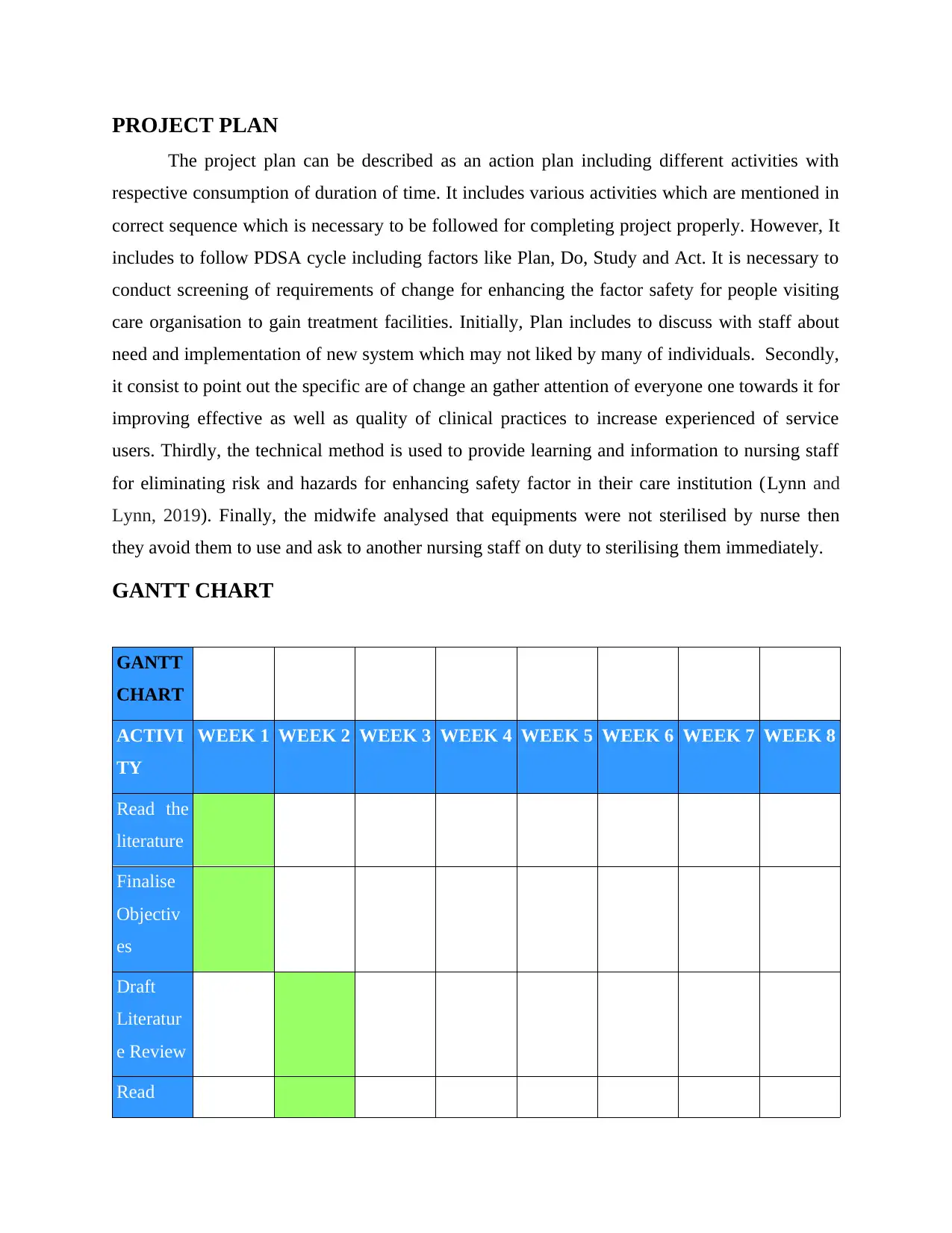
PROJECT PLAN
The project plan can be described as an action plan including different activities with
respective consumption of duration of time. It includes various activities which are mentioned in
correct sequence which is necessary to be followed for completing project properly. However, It
includes to follow PDSA cycle including factors like Plan, Do, Study and Act. It is necessary to
conduct screening of requirements of change for enhancing the factor safety for people visiting
care organisation to gain treatment facilities. Initially, Plan includes to discuss with staff about
need and implementation of new system which may not liked by many of individuals. Secondly,
it consist to point out the specific are of change an gather attention of everyone one towards it for
improving effective as well as quality of clinical practices to increase experienced of service
users. Thirdly, the technical method is used to provide learning and information to nursing staff
for eliminating risk and hazards for enhancing safety factor in their care institution (Lynn and
Lynn, 2019). Finally, the midwife analysed that equipments were not sterilised by nurse then
they avoid them to use and ask to another nursing staff on duty to sterilising them immediately.
GANTT CHART
GANTT
CHART
ACTIVI
TY
WEEK 1 WEEK 2 WEEK 3 WEEK 4 WEEK 5 WEEK 6 WEEK 7 WEEK 8
Read the
literature
Finalise
Objectiv
es
Draft
Literatur
e Review
Read
The project plan can be described as an action plan including different activities with
respective consumption of duration of time. It includes various activities which are mentioned in
correct sequence which is necessary to be followed for completing project properly. However, It
includes to follow PDSA cycle including factors like Plan, Do, Study and Act. It is necessary to
conduct screening of requirements of change for enhancing the factor safety for people visiting
care organisation to gain treatment facilities. Initially, Plan includes to discuss with staff about
need and implementation of new system which may not liked by many of individuals. Secondly,
it consist to point out the specific are of change an gather attention of everyone one towards it for
improving effective as well as quality of clinical practices to increase experienced of service
users. Thirdly, the technical method is used to provide learning and information to nursing staff
for eliminating risk and hazards for enhancing safety factor in their care institution (Lynn and
Lynn, 2019). Finally, the midwife analysed that equipments were not sterilised by nurse then
they avoid them to use and ask to another nursing staff on duty to sterilising them immediately.
GANTT CHART
GANTT
CHART
ACTIVI
TY
WEEK 1 WEEK 2 WEEK 3 WEEK 4 WEEK 5 WEEK 6 WEEK 7 WEEK 8
Read the
literature
Finalise
Objectiv
es
Draft
Literatur
e Review
Read
⊘ This is a preview!⊘
Do you want full access?
Subscribe today to unlock all pages.

Trusted by 1+ million students worldwide
1 out of 24
Related Documents
Your All-in-One AI-Powered Toolkit for Academic Success.
+13062052269
info@desklib.com
Available 24*7 on WhatsApp / Email
![[object Object]](/_next/static/media/star-bottom.7253800d.svg)
Unlock your academic potential
Copyright © 2020–2025 A2Z Services. All Rights Reserved. Developed and managed by ZUCOL.





